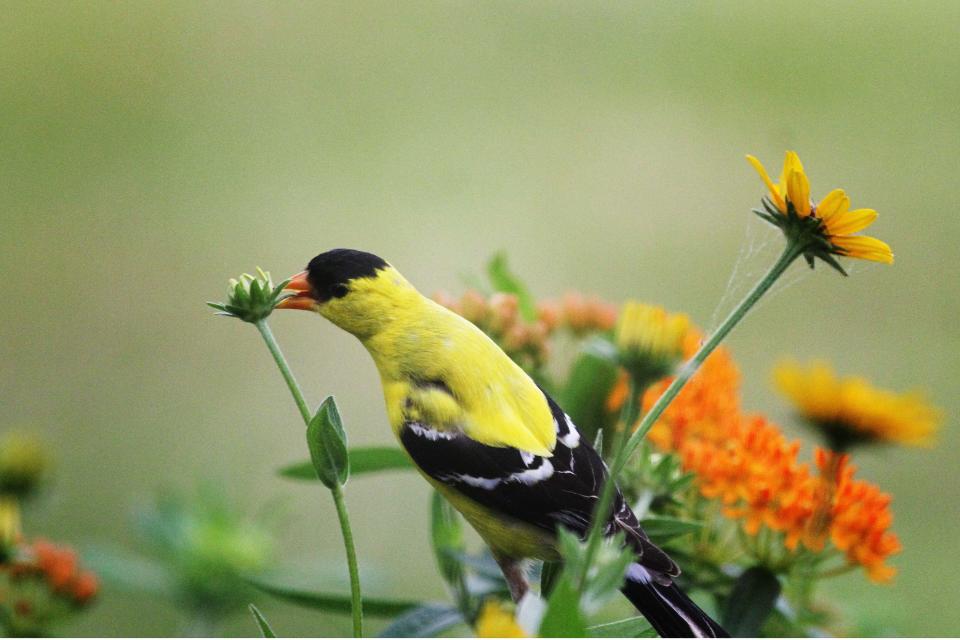Sorenson: No matter your property size, the right plants can help you attract birds
To support birds and pollinators in home landscaping, typical resources tout mostly sizeable native plants − towering trees, robust shrubs, hefty vines, and rigorous perennials.
For bird lovers living in apartments, condos, or even patio homes, however, limited space seems to preclude the opportunity to grow native to support wildlife.
Not so. After moving from a three-acre certified nature preserve to an apartment with a 10-foot-by-12-foot patio, I was determined to attract birds in a miniaturized native perennial garden. So I'm here to avow that perennials in pots work.
The proof? In my first year, the patio hosted 54 species of birds, 24 species of butterflies and moths, and uncounted bird-food insects. I was more than pleased.
Granted, choosing pot size (necessarily huge for space for extensive root systems), proper planting soil (not commercial potting mix or fertilizers) and suitable native plants (many too unruly to contain in pots) forced me to struggle along a steep learning curve.

To make the challenge more difficult, little research explores what will and will not behave appropriately in pots − much less overwinter in said pots..
While Doug Tallamy's works and the Homegrown National Park website offer suggestions and while Missouri Wildflower Nursery has explored native perennial survival in pots for several years, neither focused specifically on plants that support birds, bees and butterflies − my purpose in planting natives.
But significant research does identify native plants outside of pots that fill the bill, so those suggestions offered a place to start.
That, and my previous gardening experience.
The biggest problem: Not all native plants are created equal. Some grow way too tall, sprawl across too much space, die back too early in the season, or otherwise turn unattractive long before first frost. On the other hand, some do show good behavior, combine well with others to offer three-season bloom and, yes, attract the bees and butterflies that in turn attract birds.
Here are my four favorites, most also endorsed by Talley and Missouri Wildflower Nursery. All are straight natives − no cultivars, no hybrids.
Mountain Mint (Pycnanthemum muticum or P. virginianum) came out tops in my books, attracting a record number of pollinators over its long white-blooming season and then bursting with prolific seed heads for birds' early winter foraging.
Star Tickseed (Coreopsis pubescens) came in second, blooming gold mid-spring until frost, attracting pollinators to nectar and birds to seed.
Purple Coneflower (Echinacea purpurea), its nectar drawing bees and butterflies and its seed serving favorite bird feed, merited my search for pure native amid the dozens of cultivars and hybrids.
Blue-stemmed Goldenrod (Solidago caesia), short and well-behaved, sports welcome yellow fall color and serves as a fall insect host, assuring birds a delicious buffet.
In response to growing interest in raising perennial natives in pots, I'll teach a Bird Lovers' class called "Landscaping in Any Sized Pot or Plot." As part of the University of Evansville's non-credit Continued Learning program, this course focuses on why and how to plant natives that attract birds, bees, and butterflies.
Recommendations apply no matter the size of one's available property, from acres to patio pots. The class meets on five consecutive Thursdays, April 4-May 2, from 2-3:30 p.m. The $55 fee includes multiple handouts each session. To register, visit the website evansville.edu/centerforlearning/cluecourses.cfm.
For more information about birds and bird habitat, see Sharon Sorenson's books How Birds Behave, Birds in the Yard Month by Month, and Planting Native to Attract Birds to Your Yard. Follow daily bird activity on Facebook at SharonSorensonBirdLady, or email her at chshsoren@gmail.com.
This article originally appeared on Evansville Courier & Press: What plants bring birds to my yard?

